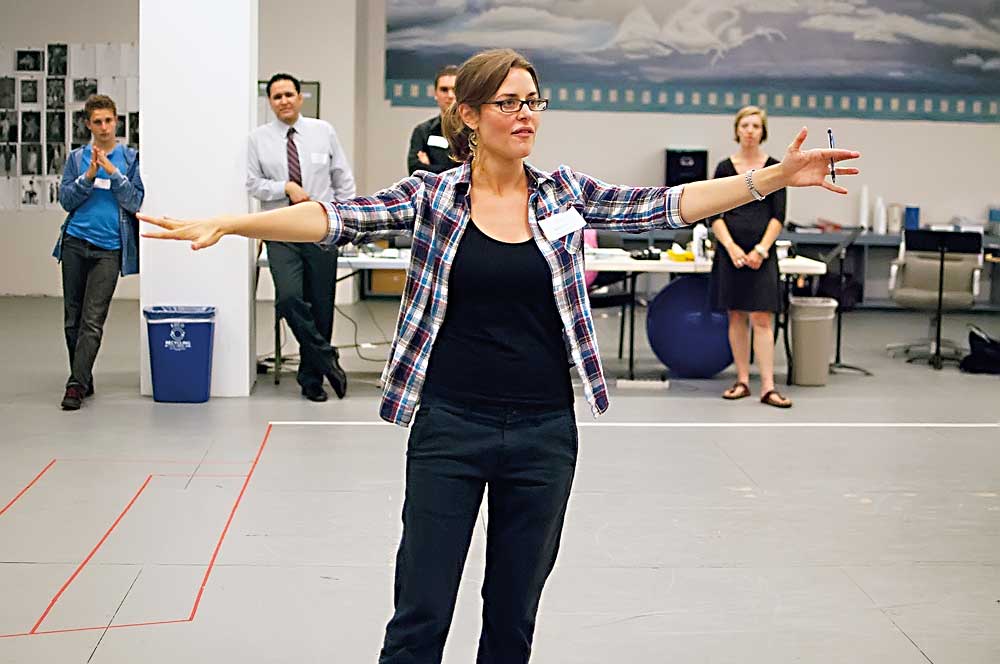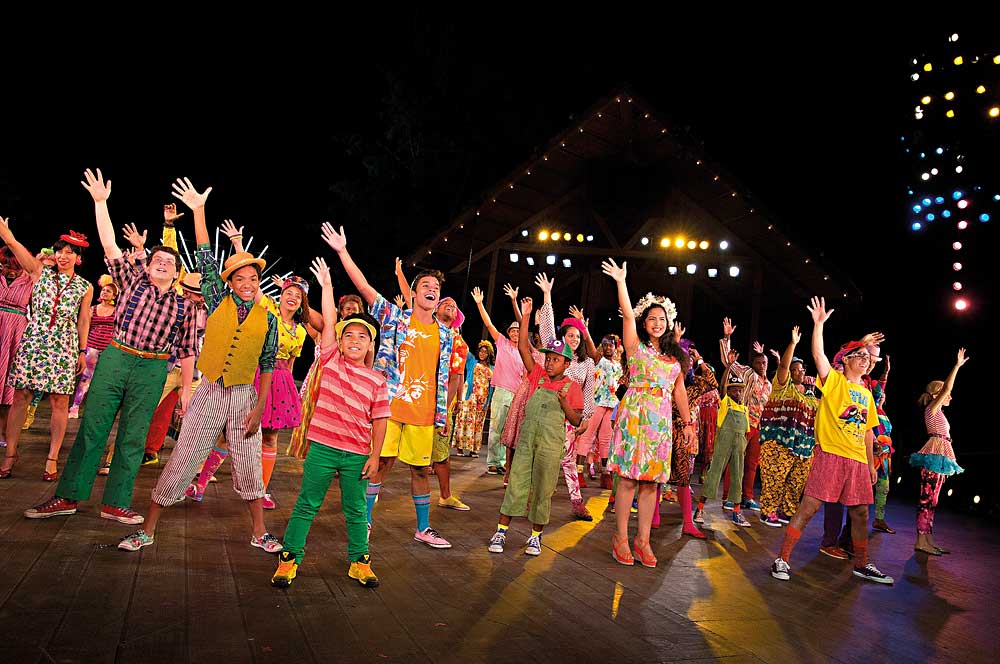
Lear deBessonet is trying to solve a problem. At one point in Shakespeare’s late romance The Winter’s Tale, 16 years pass in the blink of an eye, and the moment calls for capital-T theatricality. What would be the right choice? Should she have the Calpulli Mexican Dance Company swarm onto the Delacorte Theater stage, as it did at a critical juncture last year in deBessonet’s production of The Tempest? Should she fling her entire 200-person cast into flash-forward, creating an ensemble number to shake the floorboards? Or should she just dress the Mayor of New York up like a clock and ask him to make an announcement? It’s not your typical directing dilemma.
Since she started the Public Theater’s Public Works program, this is the sort of quandary deBessonet grapples with on a regular basis. Now in its second year, Public Works produces free, massive, community-cast musicals in Central Park’s Delacorte amphitheatre—a sort of postlude to the Public’s main Shakespeare in the Park season—while maintaining a year-round program of readings, workshops, classes and arts projects with participant groups in every one of New York’s five boroughs. This summer’s project, ironically, is The Winter’s Tale,which is trying to recapture the lightning-in-a-bottle splash made by last year’s inaugural Tempest.
Outside of Public Works, deBessonet, 33, has a growing reputation as a music-theatre innovator and has been swooned over far and wide for her dazzling, music-soaked 2013 production of Bertolt Brecht’s Good Person of Szechwan. It took home stacks of Obies and Lortel awards, and the New York Times’s Charles Isherwood, reviewing the show’s transfer from LaMaMa E.T.C. to the Public, kvelled, saying, “You may be taken aback to find how purely entertaining [Brecht’s] work can be when it is delivered with invention and a spirit of inquisitive exuberance.”
In fact, turn around in New York these days and you’ll bump into a musical deBessonet is part of creating or reinventing: At this summer’s New York City Center Encores! Off-Center series, she directed a concert staging of Pump Boys and Dinettes, and she is busy helping to develop Duncan Sheik and Steven Sater’s new musical Alice by Heart, inspired by Lewis Carroll’s Alice’s Adventures in Wonderland.
At first glance, deBessonet seems to have almost ridiculously catholic tastes. What connects these many pursuits—the indie-rock-infused Brecht, the Broadway-pedigreed musical, the community-cast civic drama? She would argue that they are all fruits of the same tree; each in its own way addresses her overriding concerns about how we create our living community—how we model right action and envision a better reality.
“It’s all the same impulse,” she says. “The musical is our fantasy of an ordered world.”
DeBessonet has an unusual background for a theatre director. Raised in Baton Rouge, La., she saw no professional theatre productions before the age of 17. (This didn’t stop her, however, from directing a “fully realized” production of Annie at her eighth birthday party. The family dog is not remembered as having been enthusiastic.) She was also raised as a devout Christian, completely invested in the millennialism of evangelical faith. When she was just 10, for instance, she underwent a terrifying and intense experience: An uncanny growling emanated from the Earth, and the house shook. Young Lear’s faith was firm, so she packed a bag, ready for the Rapture. Then the shaking stopped. The washing machine had just run an off-balance load.

Listen to deBessonet tell this story, and watch her dissolve in helpless laughter—slightly aghast at her remembered self. But another story from her days in a youth ministry sobers her right up. When she was a thrilled and idealistic 13-year-old on a missionary trip to rural Mexico, she found herself asking lifelong Catholics whether they had “accepted Jesus.” What was she doing? These were grandmothers with long lives lived in faith. She had an out-of-body moment; the ground shifted; and she came suddenly alive to the absurdity of such so-called “outreach.” It may have been the moment that turned her from a preacher to a listener.
Later, when deBessonet first came to New York, she underwent what she now refers to as a “deep spiritual crisis.” At first she was her own theatrical community of one—while getting her degree from the University of Virginia in political and social thought, she had directed up a storm. But she moved to New York without the comforting built-in clique of the theatre grad student. She trained with Anne Bogart’s SITI Company, working as her assistant director, and almost immediately began devising her own work in a company of her own creation.
I have known the Lear deBessonet that emerged from that experience, and her subsequent oeuvre, for more than a decade. That work includes an atmospheric collage piece called The Eliots; a drifting meditation on Jerusalem Syndrome called transFigures; and a darkly lyrical staging of Deborah Stein’s exploration of the invention of the X-ray, Bone Portraits. Mentored (and sometimes employed) by such theatre visionaries as Bogart, Marianne Weems and Martha Clarke, deBessonet cultivated an aesthetic you could describe as documentary, abstract, metaphysical, dancerly—a bit like what might have happened had, say, Pina Bausch made The Laramie Project on a shoestring.
Then, in 2007, things shifted. “I had two different trajectories—my artistic work and my social concerns,” she explains, “and they were completely separate things.” One of her justice-minded projects, a free-ticketing program she created at the Culture Project called Tickets for the People, changed that—in part because it was a disaster. “That was very, very painful,” she recalls, “It was a catalyzing failure. Yes, it technically succeeded, in that people were brought to see shows, but we didn’t come close to the intended results. Sitting among them, I could feel how we were just amplifying their feelings of alienation.”
So deBessonet decided she didn’t want to keep her passions separate anymore. “It all had to be one thing,” she reasons. She deliberately wed the two trajectories in 2009 by partnering with Philadelphia’s Broad Street Ministry to make Quixote, a gypsy-punk version of Man of La Mancha with a 45-strong cast that combined professional theatre actors and the church’s community—some of whom were homeless. Playwright Lucy Thurber adapted the text, making some scenes removable in case transient cast members weren’t able to get to the show. The result was colorful, puppet-filled, ebullient and moving—much of its success thanks to the music provided by the anarchist Christian punk band the Psalters, who stamped the ground, yelled about uplift and growled out the kind of music that makes you want to build a barn.
An ethical change led naturally to an aesthetic one. Some of the underpinnings of her new approach came from director Michelle Hensley, with whom deBessonet has maintained a long and close relationship. At Hensley’s Minneapolis company Ten Thousand Things, which takes its work directly into prisons and shelters, the emphasis is on the richness of diverse audiences. Hensley taught deBessonet that big, ambitious stories—ones set in fairy tale or fable-like worlds—allow audiences to participate on equal footing and actually give the people the kind of performance experience they’re looking for.
“In other words,” explains deBessonet, “people make the assumption that if a person has been in prison, he’ll want to see a show about prison. Yet if you go to the theatre with people who are actually in communities struggling with serious issues, like homelessness or the failure of the mental health system—what they want from theatre is a place to be a human.” She’s unapologetic about her embrace of populist escapism. “‘Escape’ in a homeless shelter isn’t just fun. It’s hard-won joy.”


